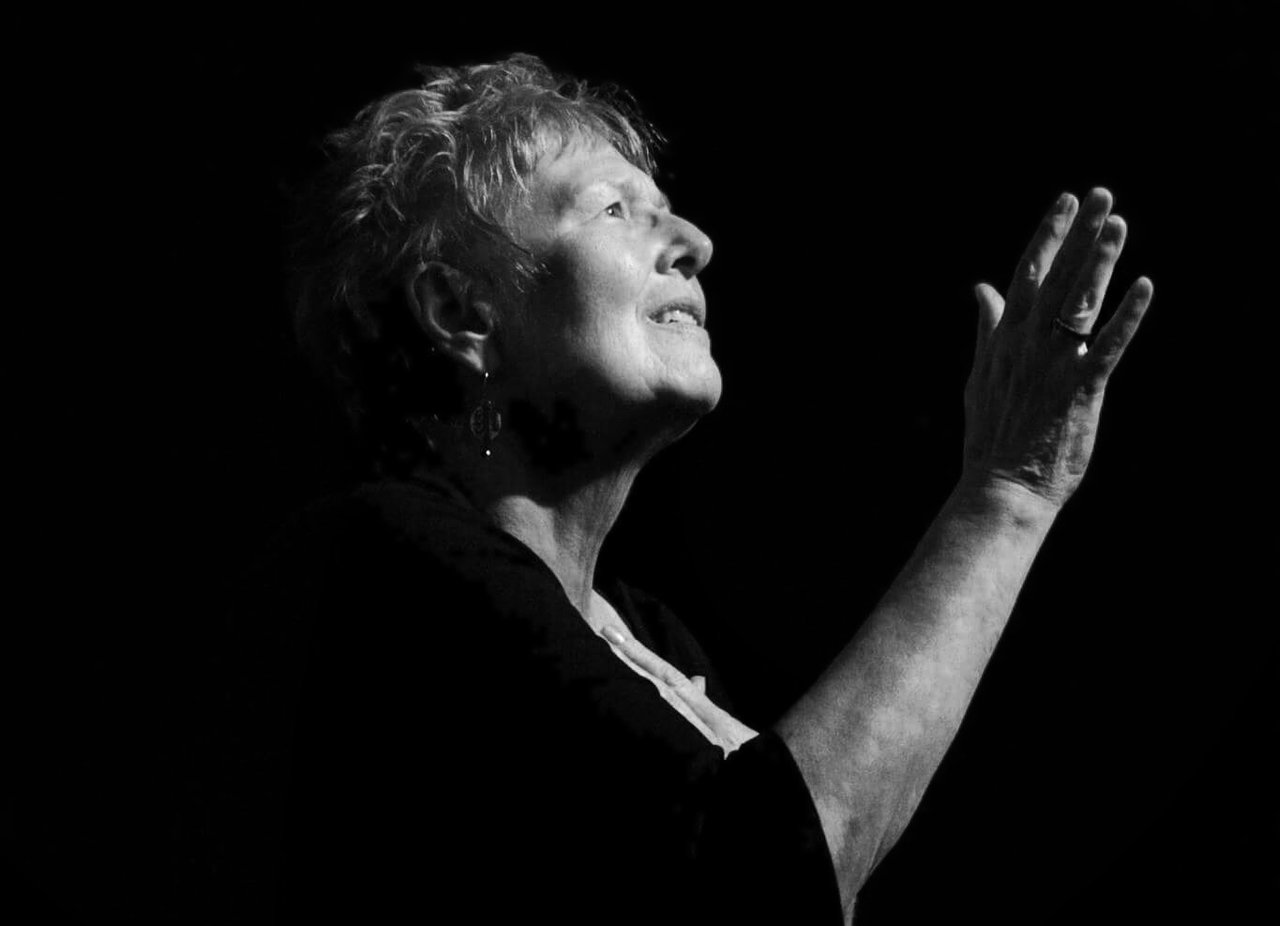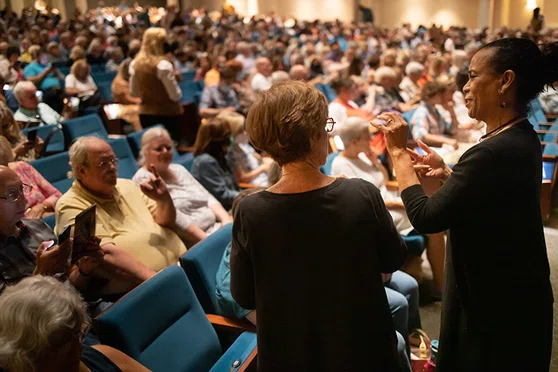


Blumenthal Performing Arts
IGNITING CULTURE
Winter 2023


HELPING HANDS
Blumenthal's Accessibility Program Reaches
a Major Milestone

Photo by Janice Rickert
Meg Tucker, founder of Stagehands Performing Arts Interpreting, interprets during a show.
by Liz Rothaus Bertrand
Blumenthal Performing Arts strives to provide a welcoming and inclusive experience to everyone in the community. Accessibility is an important part of that commitment. That’s why the theater works not only to meet, but to exceed, the requirements set out by the Americans with Disabilities Act.
Last year marked the 20th anniversary of regularly scheduled audio described performances, for people who are blind or visually impaired, as part of the Broadway Lights Season. In honor of this milestone, we go behind-the-scenes with this service and Blumenthal’s American Sign Language (ASL) series. You can also find details on other enhancements available to help guests fully enjoy their experience at the theater.
All about audio description
There’s an art behind providing quality audio description. Through hours of research, audio describers use carefully chosen words to paint a detailed, evocative picture of theatrical productions in real time. The service is provided for free via individual headsets that patrons can pick up in the theater lobby before the show. For touring Broadway productions with at least eight performances, the scheduled audio described performance usually takes place at the Sunday matinee.
In some ways audio description resembles a radio broadcast of a sporting event, says Julia Sain, former executive director of Disability Rights & Resources, a nonprofit organization based in Charlotte.
“You have the color commentator and the prep, and then you have the play-by-play,” says Sain, who has served as an audio describer for Blumenthal events since the program’s inaugural season in 2002. She is one of the eight describers who currently work on Blumenthal shows.
Prior to the first act and again during intermission, two audio describers team up to provide a thorough introduction to the show. They describe key aspects of the set, the cast of characters – including any distinguishing physical characteristics or dress – and any background information that can help participants better visualize the production.
During the performance, their narration is sparse, limited to comments that further the story or the character and don’t interfere with singing or dialogue. Description should never break the spell of the show.
“I want to be the salt in the stew,” Sain says.
In some ways audio description resembles a radio broadcast of a sporting event, says Julia Sain, former executive director of Disability Rights & Resources, a nonprofit organization based in Charlotte.
“You have the color commentator and the prep, and then you have the play-by-play,” says Sain, who has served as an audio describer for Blumenthal events since the program’s inaugural season in 2002. She is one of the eight describers who currently work on Blumenthal shows.
Prior to the first act and again during intermission, two audio describers team up to provide a thorough introduction to the show. They describe key aspects of the set, the cast of characters – including any distinguishing physical characteristics or dress – and any background information that can help participants better visualize the production.
During the performance, their narration is sparse, limited to comments that further the story or the character and don’t interfere with singing or dialogue. Description should never break the spell of the show.
“I want to be the salt in the stew,” Sain says.

Photo by Brian Twitty
From left, Tricia Crawley and Amanda Wilson give a play-by-play on what's happening onstage during an Audio Described performance.
Because the service relies on discreet technology, most people in the audience would never know this is happening behind-the-scenes, but it can make a huge difference for those who choose to use it.
“It puts me in touch with what’s going on and relieves (my companions) of having to tell me what’s going on,” says Tom Hocutt, who has been blind since birth. He attended an audio described performance pre-pandemic at Belk Theater. “It just made it so much more enjoyable,” he says.
Providing audio description upon request is a requirement under the ADA. But Sain says the great thing about incorporating it as a regular part of Blumenthal’s offerings is that it enables the describers to better prepare and deliver the highest quality service possible.
“It’s a great team,” says Tommy Cantrell, Blumenthal’s director of front of house operations, noting the group’s support for one another, ability to laugh and take constructive criticism.
Blumenthal’s audio describers have also recently expanded their impact. Cantrell says the new Tanger Center in Greensboro reached out to Blumenthal for advice on starting its own audio description series. The Charlotte-area group is now filling that need as well as accommodating requests from the Peace Center in Greenville, South Carolina, for certain touring shows.

Interpreters Linda Campbell, left, and Pamela Smith address an audience.
A Look at ASL Interpreted Shows
Blumenthal also offers regularly scheduled ASL interpreted shows, a program that has been in place for more than 20 years.
Typically, two or three interpreters team up for each production. “We see the show on Tuesday when it comes in and by Sunday we have to be ready to do it,” says Meg Tucker, founder of Stagehands Performing Arts Interpreting. “But we have been working on it for months before that.”
Just like the actors, the interpreters need to learn the show and be ready to perform it live.
ASL is a unique visual language based around concepts rather than vocabulary. For example, Tucker says there are about 40 different ways to sign the word, “run.” Translating it into ASL depends on the context: a runny nose, running for president, a run in your hose, a running faucet, running a meeting, running a race … Each is signed differently.
Tucker says the grammatical structure of ASL also differs from spoken English so it’s not possible to translate text or song lyrics word by word. Facial expression and physical gestures are key components of ASL. For a musical, interpreters use their entire bodies to convey the artistry, rhythm and “feel” of a song.
“They have to look through us to see what’s going on,” says Tucker, who has been interpreting live arts events in Charlotte for about a decade and providing similar services in Columbus, Ohio, for many years.
Unlike audio description, which takes place during pauses, ASL interpretation must happen simultaneously with any dialog or singing in a production.
For Blumenthal’s ASL-interpreted Sunday matinees, the interpreters typically sign from house right in the front orchestra section. How they divide up parts depends on who appears onstage together. Tucker usually creates a special interpreters’ program to share with deaf or hard of hearing guests that explains how each character’s name will be signed.
She also tries to meet deaf or hard of hearing audience members in the theater prior to the performance to make sure they can understand each other. Whether a person learned to sign at home or school or if he or she is partially hearing can affect someone’s fluency in sign language.
Altogether it’s time-consuming work.
“We do it because we love it,” says Tucker, who praises Blumenthal for providing the service as a regular feature of its programming.
“Suddenly deafness has exploded in the media but Blumenthal’s been doing it forever, and I think that’s really commendable … It's great to see that deaf people are getting more access, and technology has been a major boon, but still, it’s a fight for them every day. You know, you wake up in the morning and you think, ‘What do I have to do today and how am I going to do it? How am I going to interact?’ And we don’t have to do that as hearing people.”◼
More information on accessibility
- All of Blumenthal’s theaters are wheelchair accessible.
- Most water fountains and restrooms within each facility are also wheelchair accessible. (Belk Theater also has a private unisex restroom located in the grand tier lobby if a patron using a wheelchair needs assistance from a companion of a different gender.)
- Large print programs are available for many performances (check at the coat check in Belk Theater’s grand tier lobby or ask an usher for assistance at other venues.)
- Assistive Listening Devices for patrons with hearing loss, with or without hearing aids, are available at coat check in Belk Theater’s grand tier lobby and mezzanine lobby. Ask an usher for assistance at other venues.
- GALAPRO, a closed captioning service delivered on mobile phones, is available for select Broadway shows at Belk and Knight Theaters.
- Wheelchair seating is available at all price levels.
- Accommodations can be made for service animals with advance notice.
- Entry and exit assistance is available with advance notice.
CLICK FOR details on accessibility at each theater
You also can phone 704.372.1000 Monday-Saturday, 10 a.m.-6 p.m.
Questions about Seating & Pricing
PHONE: 704.372.1000 (Monday-Saturday, 10 a.m.-6 p.m.)
EMAIL: tickets@blumenthalarts.org
IN PERSON: Belk Theater Box office, 130 N. Tryon St.
(Monday-Saturday, 10 a.m.-6 p.m.)



